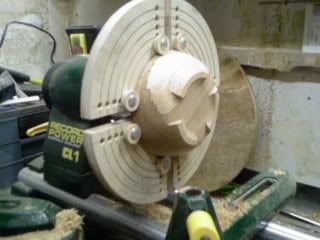For the friction drive, turn a piece of timber to fit your chuck jaws and protrude say 6" in front of the jaws. Can leave the end furtherst from the chuck a wider diameter than the chuck end if you like. Pad the far end with some washingup sponge or similar, I also stuck on some router mat to give extra grip.
That's all their is to this hi-tech device ! To use, once you have turned your bowl as normal and are ready to finish off the bottom, just grip the friction drive in the chuck jaws, hold the inside of the bowl against the friction drive and gently bring up the tailstock to gently but firmly apply some pressure to the bottom of the bowl and seat it against the friction drive.
You have to take care to apply enough pressure to keep the bowl safely in position, but not to tighten so much that you damage the bottom of the bowl with the tailstock. Also take care to ensure the tailstock is central, might take a few attempts.
Use only with low speeds and very light cuts from your gouge, preferably with a face mask also in case the bowl comes loose.
Doing it this way allows you to tidy up and/or remove the chucking recess or spigot from the bowl bottom, leaving only a small area where the tailstock supports to tidy up by hand off the lathe ( power drill and sanding pads good for that).
Sounds complicated, but with a bit of care can be done and finished before you have even got your cole jaws out of their box !
Let me know if difficult to understand and I'll try a couple of pictures later.
No such thing as silly questions, only unintelligble answers !!!
Cheers, Paul.







